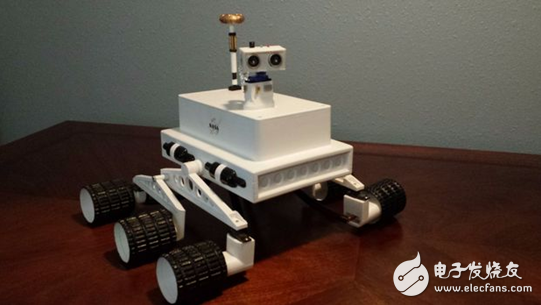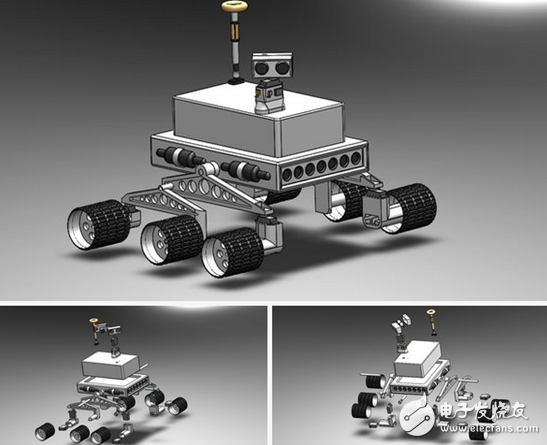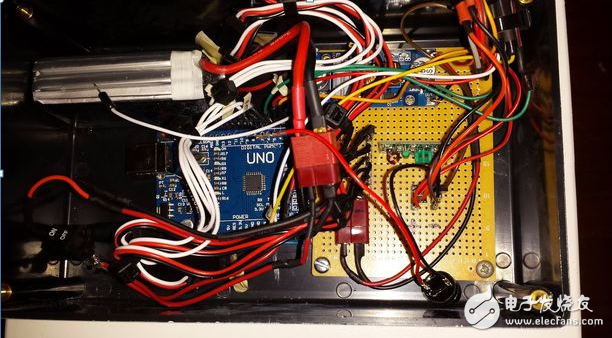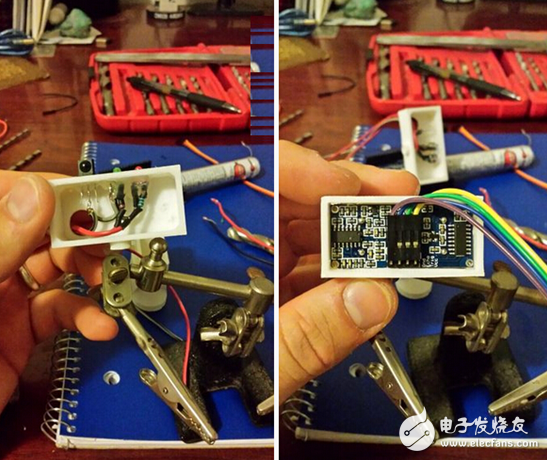
This production covers all the steps of making a lunar rover, including: the construction of STL files, the connection of various components, control systems and programming. For beginners, this is definitely a great learning opportunity. Please note during the DIY process: This project has many complicated welding, shrinking lines, and packing connectors. Moreover, the maintenance process of the continuous rotary servo system needs to be very cautious. If you are not careful, it is easy to destroy a servo.
Step 1: Components and required tools
Electronic component:
· Arduino Uno development board (1)
· DROC regulator (1)
· Hobbymate brushless motor (1)
· 1300 mAh lithium battery (1)
· Circuit board (1)
· T-connector (5)
· 5/16" wooden pin (1)
· Infrared receiver (1)
· Infrared remote control transmitter (1)
· Switch (1)
· Servo expander (8)
· MG90S steering gear (9)
· HC SR04 ultrasonic sensor (1)
· Red LED lights (1)
· Green LED lights (1)
· 22KΩ resistors (8)
· 220Ω resistors (2)
· Bolts (2)
· Nylon lock nut (2)
· #2 screws (6)
· Paper clips (4)
· Ream of Wire Loom
tool:
· Electric iron
· Flux cored welding
· Wire cutter
· Wire cutters
· Small Phillips screwdriver
· Small plum screwdriver
Other items:
· Glue
· Model paint
· Decals
· Aluminum foil
· Glued black paint
In order to keep the motor running continuously, the motor needs to be maintained and the relevant video can be found online.
Step 2: 3D printed parts and assembly


Most of the parts of this model can be printed directly on a 3D printer. Prior to this, the model reconstruction of the STL file has been completed. Four modified continuous rotary servos will need to be mounted on the drive wheel and the drive housing. The center set of the hub can be freely rotated. The black wire loop is used to hide the wires that are lifted from the drive housing and bend the rear drive housing. 5/16" wooden pins are cut into different sizes to connect the main arms to the center differential system. The rubber paint applied to the wheels is designed to increase the traction of the outer surface. To the extent of tolerance, to ensure The system is working properly and maybe some extra tools are needed. The assembly process is very simple and can be stripped from those 3D explosion pictures. To make the overall look good, you can buy some models of paint and a little aluminum foil to hide the wires. .
Step 3: Control System


The control system was started with the support of a 1300 mA lithium polymer battery. This battery is an integral part of the overall system, although it was originally purchased for the purpose of buying a spare battery. When the power supply voltage is sent to the adjustable voltage regulator, it is set to about 6.81v and is adjusted to about 5.08v, and can reach about 5V through arduino. However, because the continuous servo system receives a 6.71v voltage source and is not a 5v source, it does not operate normally. However, this problem is solved by adjusting the voltage regulator to 5.08V. Therefore, after passing through the voltage regulator, the voltage is sent to the Arduino and other components. The infrared receiver, LED, and ultrasonic sensor are all mounted on the outside of the servo. In order to facilitate the connection of Rove's components to the power supply and grounding, it is best to solder the two rows of components first. You will need to solder two rows to the PCB board to distribute all power and ground connectors for the various components of the lunar rover.
Step 4: Circuit diagram

The above picture shows the specific distribution of the components and wires of the schematic of this work. Each component is assigned a reasonable voltage and a signal sent from the Arduino board. To facilitate easy disconnection of system components for replacement or use in other projects, a T-connector can be used. In this figure, it only shows how the components are connected. The pin configuration is inconsistent with the Arduino sketch. In the actual production, please refer to the Arduino sketch for proper pin configuration.
Step 5: Sketch of Arduino
It should be noted that the value set for the stop position of the continuous rotation servo needs to be changed from time to time, because the general resistance used to disperse the voltage on the servo is not accurate, and not every one will get the same value. For example, someone's servo stop position is at 89, 88, 66, 69 degrees. In theory, the stop position should be at 90 degrees, but, as mentioned earlier, the general resistance used for the project is Not very precise. It should also be noted that any infrared remote control can be used for this project. However, it should be noted that the value of the remote control universal button will be different from the value on the Arduino sketch. There are videos on YouTube about how to find the value of your IR remote button.
Step 6: Final product and assembly
When the current button is pressed, the rudder continues to move forward until the stop button is pressed. When the steering button is pressed, the steering gear starts to work, and the wheel will drive the steering gear to turn in the direction of the will. If the steering gear is too close to the target object, the red LED will flash and the buzzer will start. To stop using, simply press the deactivate button and the main unit, and the object in its vicinity will no longer be detected and sensed.
This article is selected from the electronic enthusiast "Security Technology Special", more quality content, download now

UAV Drone Jamming Module Jammer
The operation principle of UAV Drone jamming device is mainly to interfere with UAV communication, navigation, control and other systems by emitting electromagnetic waves or other jamming signals, thus making it unable to operate or control normally.
The specific principles include:
1. Electromagnetic interference: By emitting powerful electromagnetic signals, it interferes with the communication system of the UAV, making it unable to communicate with the ground control center or operators normally, thus making the UAV out of control.
2. GPS jamming: By transmitting jamming signals, it interferes with the UAV's Global Positioning System (GPS) receiver, making it unable to accurately obtain its own position information, thus causing the UAV to be unable to navigate and locate.
3. Wireless signal interference: By transmitting interference signals, it interferes with the wireless communication signals of the UAV, making it impossible to receive or send wireless signals, thus affecting the control and command transmission of the UAV.
4. Radar jamming: By transmitting jamming signals, it interferes with the radar system of UAV, making it impossible to accurately detect the surrounding environment, thus affecting the navigation and obstacle avoidance ability of UAV.
5. Thermal interference: By emitting a high-energy laser beam or microwave beam, the UAV is attacked by thermal energy, so that its key components are damaged or invalid, thus making the UAV unable to operate normally.
Drone Jammer,UAV Drone signal blocker,Jammer Module,UAV Drone Jamming Module,Drone amplifer module,signal jammer,jammer signal blocker
Yetnorson Antenna Co., Ltd. , https://www.yetnorson.com
